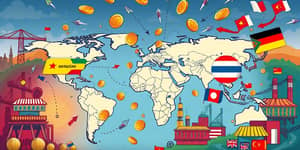The rise of emerging markets has become one of the most significant trends in the global economy over the last few decades. These nations, which are transitioning from underdeveloped to more developed status, have become increasingly important players on the world stage.
With their growing populations, increasing economic output, and expanding consumer markets, emerging markets present both opportunities and challenges for investors and policymakers alike.
Understanding the dynamics of emerging markets is crucial for anyone looking to navigate the complexities of the global economy.
As these nations develop, they often face unique circumstances that differentiate them from fully developed economies. The interplay between political, economic, and social factors makes emerging markets a subject of great interest and importance.
In this article, we will explore the definitions, historical context, characteristics, major players, and the opportunities and challenges that emerging markets present today.
Defining Emerging Markets

Emerging markets are typically defined as countries that have not yet fully developed but have potential for significant economic growth.
These nations are often characterized by rapid industrialization, growth in GDP, and improving standards of living, making them increasingly attractive for investors.
The classification of a country as an emerging market is based on several indicators including economic performance, market accessibility, and political stability.
Institutions such as the International Monetary Fund (IMF) and the World Bank categorize countries based on these criteria, allowing investors to gauge the potential risks and rewards of investment.
It is important to note that the term 'emerging markets' encompasses a diverse range of countries, each with its unique challenges and opportunities.
This diversity can lead to varying speeds of growth and development, complicating the overall investment landscape.
Historical Context

The concept of emerging markets emerged in the 1980s as a way to classify countries that were seeing significant economic transformations but had not yet reached full industrialization.
Initially, this classification was limited to a few countries, primarily in Asia and Latin America, that exhibited high rates of growth, investment, and social change.
In the years that followed, various geopolitical events, such as the fall of the Berlin Wall and the opening up of China, spurred the growth of numerous emerging markets.
This shift was characterized by liberalization, privatization, and increased global integration, allowing these economies to attract foreign investment and enhance their competitiveness on the global stage.
As globalization accelerated, emerging markets began to play a more prominent role in international trade and finance.
The economic crises of the 1990s also encouraged many of these nations to reform their policies and stabilize their economies, which paved the way for future growth and development.
Today, emerging markets are home to a significant proportion of the world's population and are expected to continue to grow at a pace that outstrips developed markets, transforming the global economic landscape.
Key Characteristics of Emerging Markets

Emerging markets share several key characteristics that distinguish them from developed economies. These traits include high growth potential, increasing urbanization, and a burgeoning middle class.
Additionally, they often have less mature market structures and higher volatility, presenting both risks and opportunities for investors.
- High economic growth rates
- Increasing urbanization
- Expanding middle class
- Volatile market conditions
- Less mature financial markets
Major Emerging Markets

Several countries stand out as leading emerging markets, each contributing uniquely to the global economy. China, India, Brazil, and Russia are often highlighted for their significant economic influence and growth trajectories.
1. China
China has emerged as the world's largest emerging market, propelled by rapid industrialization and economic reforms that began in the late 20th century.
Its transformation from a primarily agrarian society to a global manufacturing powerhouse has been unprecedented, fostering massive economic growth and development.
Today, China is a key player in the global economy, with significant investments in both infrastructure and technology. As it continues to shift towards a consumption-driven economy, understanding China’s evolving market dynamics becomes crucial for investors.
However, challenges remain, including environmental concerns, potential economic imbalances, and geopolitical tensions that could impact its growth trajectory.
- Largest emerging market
- Shift from manufacturing to consumer-driven economy
- Major global investments
2. India
India, often referred to as the world’s largest democracy, is another prominent emerging market. With its diverse economy spanning agriculture, services, and manufacturing, India has shown remarkable resilience and adaptability in the face of challenges.
The country's young population and burgeoning middle class drive demand for various goods and services, attracting substantial foreign investment.
India's economic reforms have also enhanced its competitiveness, making it a hub for technology and innovation.
Despite its potentials, India faces hurdles such as infrastructural deficits, regulatory challenges, and social disparities that could affect its growth prospects.
- Diverse economy
- Young and expanding population
- Growing middle class
3. Brazil
Brazil, as the largest economy in South America, plays a significant role within the emerging markets narrative. Rich in natural resources and agricultural output, Brazil has attracted global attention as a major exporter.
The country's growth has been driven by its vast consumer market and commodity exports; however, Brazil grapples with political instability and economic fluctuations, which undermine investor confidence.
Despite these challenges, Brazil's strategic importance in global agriculture and its efforts towards economic reform position it as a vital emerging market.
- Largest economy in South America
- Rich in natural resources
- Political instability
4. Russia
Russia's emergence as a key player in the global economy is underscored by its vast natural resource reserves, particularly in oil and gas. This dependency on resource exports has given it significant geopolitical leverage and economic power.
However, Russia's heavy reliance on these sectors makes it vulnerable to fluctuations in global commodity prices, which can impact its economic stability.
Additionally, ongoing political tensions and sanctions have complicated its economic relationships with Western nations.
As Russia navigates these complexities, understanding its market dynamics is vital for those looking to invest in or engage with this emerging market.
- Vast natural resource reserves
- Dependency on oil and gas exports
- Political tensions and sanctions
Factors Contributing to Growth

Emerging markets have several factors that contribute to their growth and development. These elements play a key role in enhancing their economic prospects and attracting investment.
The interplay of demographic trends, technological advancements, and globalization has created an environment ripe for growth in these regions.
- Young and expanding labor force
- Increased foreign investment
- Technological adoption
- Government policies promoting growth
- Enhanced trade relations
Challenges Faced by Emerging Markets

Despite their growth potential, emerging markets encounter numerous challenges that can hinder their development. These challenges vary across regions and can significantly impact investment risks and opportunities.
Addressing these challenges requires comprehensive strategies that encompass economic, social, and political dimensions.
- Political instability
- Economic volatility
- Trade barriers
- Inadequate infrastructure
- Regulatory challenges
The Role of Technology

Technology plays a pivotal role in the growth and transformation of emerging markets. From digital finance to e-commerce, advancements are helping to bridge the gap between these economies and developed nations.
In many emerging markets, mobile technology, in particular, has revolutionized communication and access to services, significantly impacting lifestyles and business models.
Investment Opportunities

Emerging markets present a wealth of investment opportunities for those willing to navigate their complexities. Sectors such as technology, healthcare, and renewable energy are rapidly growing and attracting increasing amounts of capital.
Investors can find promising avenues within these markets, but thorough research and understanding of local dynamics are essential for success.
- Technology and digital services
- Renewable energy and sustainability
- Infrastructure development
- Healthcare and pharmaceuticals
Conclusion

The rise of emerging markets signifies a monumental shift in the global economic landscape. As these nations continue to grow and evolve, they will undoubtedly play an increasingly vital role in shaping the future of the global economy.
Understanding the characteristics, challenges, and opportunities inherent in these markets is essential for investors, policymakers, and those engaged in international business.
As the world becomes more interconnected, staying informed about emerging markets will be crucial for navigating the complexities of the global economy.
Ultimately, emerging markets offer a compelling narrative of opportunity, growth, and transformation, making them worthy of attention and investment in the years to come.










